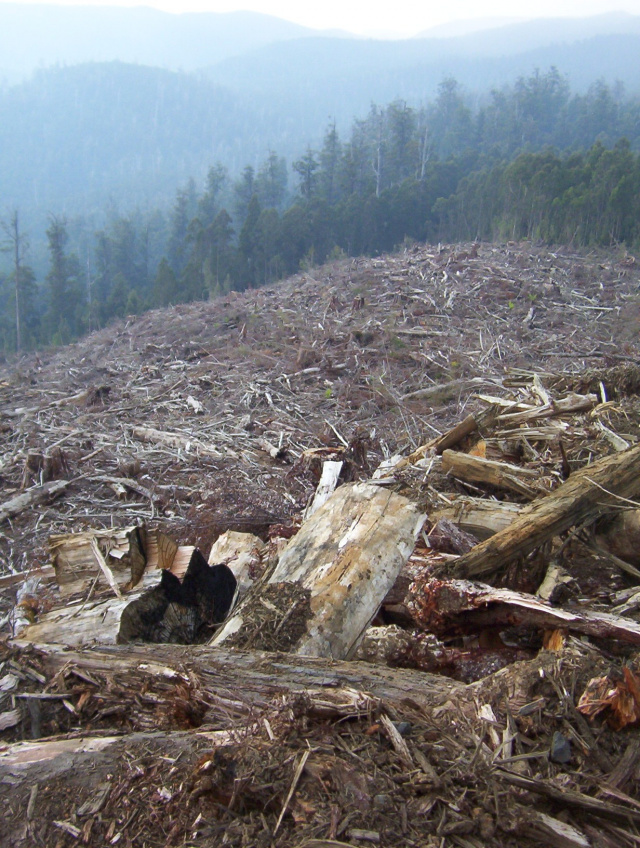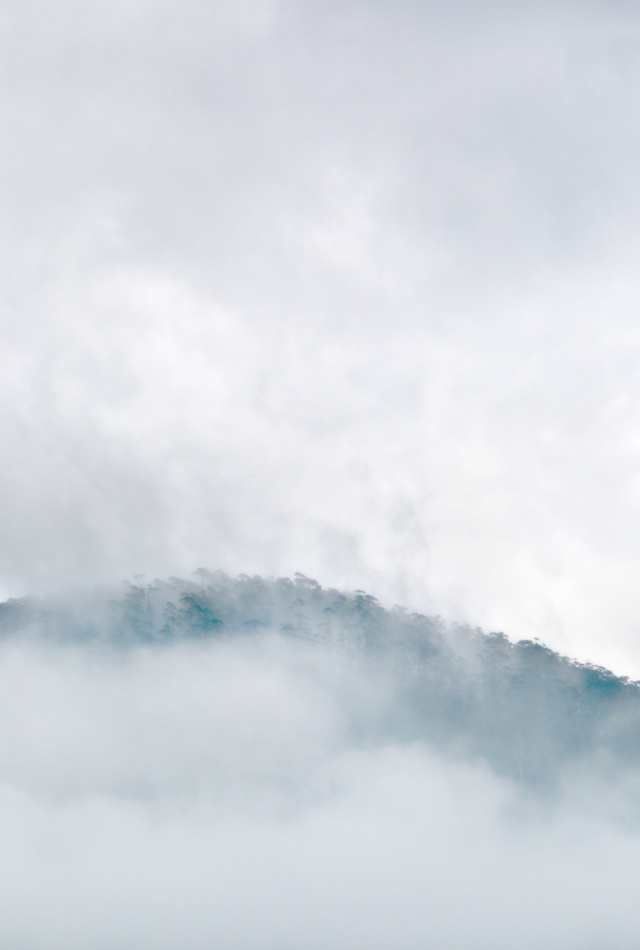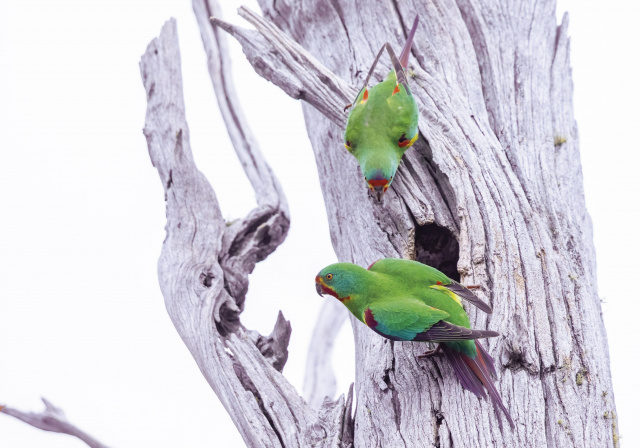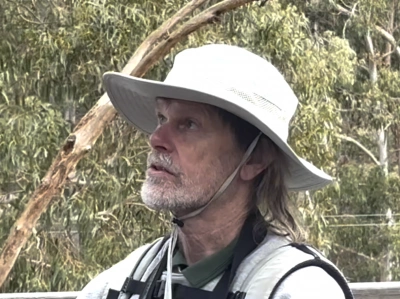The future of the Swift Parrot looks bleak, and doing something about it is incredibly challenging. There are lots of things impacting on this bird and we have done very little as a society to help this bird. It is difficult, because there's a lot of interest groups involved and industries involved, and a lot of different pressures on the Swift Parrot. It's really challenging to deal with this because we're dealing with different interests, including economic interests, like forestry, agriculture, apiculture, and the building industry. So there are a whole lot of things that stand in the way of the recovery of the Swift Parrot.
But we have to, as a society, ask ourselves, do we want to have a world with Swift Parrots, or don't we? And if we do, we've got to do something about it and we've got to do it right now because we're running out of time really fast. Here are some critical challenges for the Swift Parrot, and what we, as a society, need to think about doing to turn each challenge around:
But we have to, as a society, ask ourselves, do we want to have a world with Swift Parrots, or don't we? And if we do, we've got to do something about it and we've got to do it right now because we're running out of time real fast.
(Recently reclassified as Krefft's Gliders, these Gliders are native to mainland Australia but are an introduced species in Tasmania).
Now doing something about Sugar Gliders is really difficult because we don't know a great deal about their ecology, because they're nocturnal, they're in forests, and they're hard to find.
So it's difficult to either control their population or change their behaviour to stop them eating Swift Parrots at the rates that they're doing. It's going to take a whole lot of research to come up with a solution to the glider.

So protecting habitat is a really important way of not making the glider problem even worse than it is.
We need to stop destroying habitat because that's just going to make the situation for the Swift Parrot worse. So stopping clearance of Old-Growth forest and foraging habitat in Swift Parrot breeding areas is critical.
So stopping clearance of Old-Growth forest and foraging habitat in Swift Parrot breeding areas is critical.

So making use of these areas as Sugar Glider-free zones, as places where Swift Parrots can breed safely, is one way of tipping the balance a little bit and just trying to give us a bit more time, so that we can come up with a solution to the glider problem on the main island of Tassie. So getting more Swift Parrots onto these islands Is one critical thing that we can do. To achieve this, we can plant more foraging habitat. The thing that really drives where the Swift Parrots go to nest each year is how much food is available.
So if we made more food available on these glider-free islands, we could get more Swift Parrots attracted to these areas where they're not going to be eaten by gliders.

But if we plant the trees, it's going to take 20 years or so before they start flowering, and the model's predicting that in 20 years' time we're not going to have Swift Parrots left in the wild. So we need to find a way of getting more food quickly into the environment.
One thing that we could do is to plant other species of eucalypt, which flower precociously. So instead of waiting 20 years for flowers, we've only got to wait five years. There are species of trees which occur on the Australian mainland, which will do that. These are trees that are grown as ornamentals in Tasmania, and we know that Swift Parrots will feed on them during their breeding season. If we plant those on Bruny Island, that's one way of getting some quick forage. But they're still waiting five years for flowers, and even five years is really too long in terms of trying to save the Swift Parrot.

The simple solution is to reduce competition for the available food in those flowers. So we will have the same number of flowers but we have more nectar in each flower. To achieve that, we need to reduce the consumption of nectar by introduced species and in particular, honeybees. Because honeybees are a colonial animal and they can communicate the whereabouts of nectar, they can very efficiently exploit resources. It takes just one honeybee to find a flowering Blue Gum, and they'll go back to their hive and tell all their mates and then there will be tens of thousands of bees on a tree and they can strip the nectar completely out of the flowers and leave nothing for Swift Parrots. So as soon as it's warm enough for honeybees to fly, there can be no food for Swifties. If we could reduce the numbers of honeybees on Bruny Island and Maria Island that would be one way of increasing food availability for Swift Parrots on these Sugar Glider-free islands and attracting more Swift Parrots onto these islands where they're not going to get eaten by gliders.

Another thing we need to do is have a very serious discussion about captive breeding as a potential tool and see whether we can use that as a way of prolonging the existence of the species until we can get more habitat back into the landscape.
At the moment, we've got this thing about glass. New houses have got so much glass in them and Swift Parrots don't see that and think it's a clear flight path. They also see reflections of trees on the glass, and think that's forest. They can't stop quickly enough and they crash into it and die. So this is something that we need to be addressing in building designs.
So stopping making it worse isn't enough. We've actually got to turn it around and start making it better, and that means positive actions, as well as stopping those negative actions. For example, there was a nesting box project that was set up for Swift Parrots, as that is a way of enhancing habitat on these glider free islands.
The Swift Parrot nest box project worked really well, initially. Boxes were put up in 2016 on North Bruny when there was a big influx of Swift Parrots, because there was a lot of flowering going on. The Swift Parrots used those boxes and bred successfully in them. The number of fledglings produced per nest and the body condition of those fledglings was just as good from boxes as it was from natural hollows.
But the problem encountered was that after the Swift Parrots finished using them the boxes were left up, and it was another three years later when there was another big influx of Swift Parrots. When they came back almost half of the boxes were occupied by starlings. So when they first put them up in 2016, they found seven starling nests in the boxes. Three years later, there were 59 starling nests in the boxes. So the starlings had found them and were just breeding in them and making more starlings, which went off and occupied more boxes. So this resource that was put there for Swift Parrots actually wound up breeding a nest hole competitor, and so that resource was being rapidly diminished. So if we're using nest boxes we've got to put them up when the parrots need them and then either close off the entrance, or take them back down again until there's another big influx of Swift Parrots.
So nest boxes are a tool that can be used, and it's promising, but it's got to be done properly, and it takes a lot of time and resources to do that, because it involves tree climbing, which costs a lot of money. Where nest boxes come in useful is where there isn't much Old-Growth forest. So on North Bruny, there's not as much Old-Growth forest, so that's where nest boxes come in really handy. South Bruny on the other hand, for example, still has a lot of Old-Growth forest on it, and so there's a lot of natural hollows there that Swift Parrots can use.
The Swift Parrot nest box project worked really well, initially. Boxes were put up in 2016 on North Bruny when there was a big influx of Swift Parrots, because there was a lot of flowering going on, and the Swift Parrots came in, and they used those boxes and bred successfully in them.

The future of the Swift Parrot looks bleak, and doing something about it is incredibly challenging. There are lots of things impacting on this bird and we have done very little as a society to help this bird. It is difficult, because there's a lot of interest groups involved and industries involved, and a lot of different pressures on the Swift Parrot. It's really challenging to deal with this because we're dealing with different interests, including economic interests, like forestry, agriculture, apiculture, and the building industry. So there are a whole lot of things that stand in the way of the recovery of the Swift Parrot.
But we have to, as a society, ask ourselves, do we want to have a world with Swift Parrots, or don't we? And if we do, we've got to do something about it and we've got to do it right now because we're running out of time really fast. Here are some critical challenges for the Swift Parrot, and what we, as a society, need to think about doing to turn each challenge around:
But we have to, as a society, ask ourselves, do we want to have a world with Swift Parrots, or don't we? And if we do, we've got to do something about it and we've got to do it right now because we're running out of time real fast.
(Recently reclassified as Krefft's Gliders, these Gliders are native to mainland Australia but are an introduced species in Tasmania).
Now doing something about Sugar Gliders is really difficult because we don't know a great deal about their ecology, because they're nocturnal, they're in forests, and they're hard to find.
So it's difficult to either control their population or change their behaviour to stop them eating Swift Parrots at the rates that they're doing. It's going to take a whole lot of research to come up with a solution to the glider.

So protecting habitat is a really important way of not making the glider problem even worse than it is.
We need to stop destroying habitat because that's just going to make the situation for the Swift Parrot worse. So stopping clearance of Old-Growth forest and foraging habitat in Swift Parrot breeding areas is critical.
So stopping clearance of Old-Growth forest and foraging habitat in Swift Parrot breeding areas is critical.

So making use of these areas as Sugar Glider-free zones, as places where Swift Parrots can breed safely, is one way of tipping the balance a little bit and just trying to give us a bit more time, so that we can come up with a solution to the glider problem on the main island of Tassie. So getting more Swift Parrots onto these islands Is one critical thing that we can do. To achieve this, we can plant more foraging habitat. The thing that really drives where the Swift Parrots go to nest each year is how much food is available.
So if we made more food available on these glider-free islands, we could get more Swift Parrots attracted to these areas where they're not going to be eaten by gliders.

But if we plant the trees, it's going to take 20 years or so before they start flowering, and the model's predicting that in 20 years' time we're not going to have Swift Parrots left in the wild. So we need to find a way of getting more food quickly into the environment.
One thing that we could do is to plant other species of eucalypt, which flower precociously. So instead of waiting 20 years for flowers, we've only got to wait five years. There are species of trees which occur on the Australian mainland, which will do that. These are trees that are grown as ornamentals in Tasmania, and we know that Swift Parrots will feed on them during their breeding season. If we plant those on Bruny Island, that's one way of getting some quick forage. But they're still waiting five years for flowers, and even five years is really too long in terms of trying to save the Swift Parrot.

The simple solution is to reduce competition for the available food in those flowers. So we will have the same number of flowers but we have more nectar in each flower. To achieve that, we need to reduce the consumption of nectar by introduced species and in particular, honeybees. Because honeybees are a colonial animal and they can communicate the whereabouts of nectar, they can very efficiently exploit resources. It takes just one honeybee to find a flowering Blue Gum, and they'll go back to their hive and tell all their mates and then there will be tens of thousands of bees on a tree and they can strip the nectar completely out of the flowers and leave nothing for Swift Parrots. So as soon as it's warm enough for honeybees to fly, there can be no food for Swifties. If we could reduce the numbers of honeybees on Bruny Island and Maria Island that would be one way of increasing food availability for Swift Parrots on these Sugar Glider-free islands and attracting more Swift Parrots onto these islands where they're not going to get eaten by gliders.

Another thing we need to do is have a very serious discussion about captive breeding as a potential tool and see whether we can use that as a way of prolonging the existence of the species until we can get more habitat back into the landscape.
At the moment, we've got this thing about glass. New houses have got so much glass in them and Swift Parrots don't see that and think it's a clear flight path. They also see reflections of trees on the glass, and think that's forest. They can't stop quickly enough and they crash into it and die. So this is something that we need to be addressing in building designs.
So stopping making it worse isn't enough. We've actually got to turn it around and start making it better, and that means positive actions, as well as stopping those negative actions. For example, there was a nesting box project that was set up for Swift Parrots, as that is a way of enhancing habitat on these glider free islands.
The Swift Parrot nest box project worked really well, initially. Boxes were put up in 2016 on North Bruny when there was a big influx of Swift Parrots, because there was a lot of flowering going on. The Swift Parrots used those boxes and bred successfully in them. The number of fledglings produced per nest and the body condition of those fledglings was just as good from boxes as it was from natural hollows.
But the problem encountered was that after the Swift Parrots finished using them the boxes were left up, and it was another three years later when there was another big influx of Swift Parrots. When they came back almost half of the boxes were occupied by starlings. So when they first put them up in 2016, they found seven starling nests in the boxes. Three years later, there were 59 starling nests in the boxes. So the starlings had found them and were just breeding in them and making more starlings, which went off and occupied more boxes. So this resource that was put there for Swift Parrots actually wound up breeding a nest hole competitor, and so that resource was being rapidly diminished. So if we're using nest boxes we've got to put them up when the parrots need them and then either close off the entrance, or take them back down again until there's another big influx of Swift Parrots.
So nest boxes are a tool that can be used, and it's promising, but it's got to be done properly, and it takes a lot of time and resources to do that, because it involves tree climbing, which costs a lot of money. Where nest boxes come in useful is where there isn't much Old-Growth forest. So on North Bruny, there's not as much Old-Growth forest, so that's where nest boxes come in really handy. South Bruny on the other hand, for example, still has a lot of Old-Growth forest on it, and so there's a lot of natural hollows there that Swift Parrots can use.
The Swift Parrot nest box project worked really well, initially. Boxes were put up in 2016 on North Bruny when there was a big influx of Swift Parrots, because there was a lot of flowering going on, and the Swift Parrots came in, and they used those boxes and bred successfully in them.

You might like...

Blue Gums and Swifties

The Swift Parrot - An incredible bird

Bruny and Maria Island critical for Swift Parrot's survival

Bruny Island nesting box project
Newsletter
Sign up to keep in touch with articles, updates, events or news from Kuno, your platform for nature

